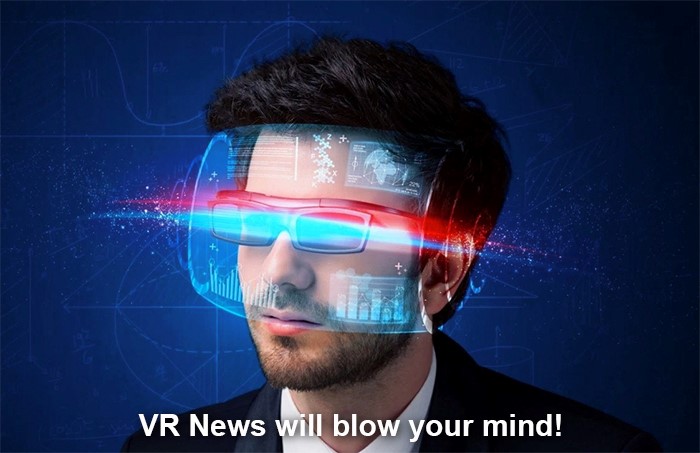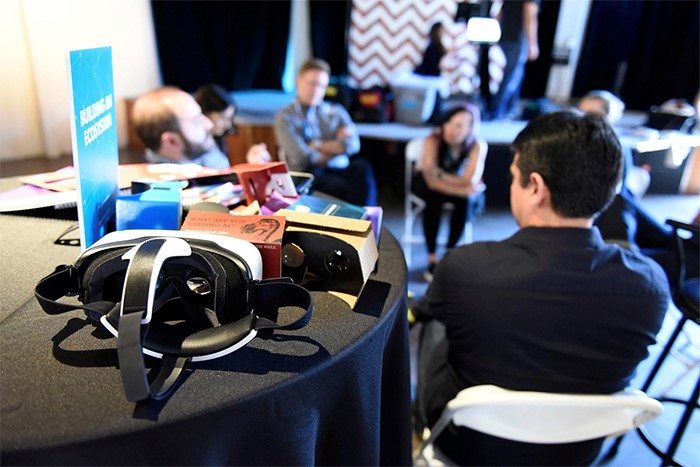How virtual reality will transform the future of news
Viewers will become addicted to VR broadcasts
Thomas Frey //November 15, 2016//


How virtual reality will transform the future of news
Viewers will become addicted to VR broadcasts
Thomas Frey //November 15, 2016//

The year is 2026.
When the police arrested the couple for human trafficking, a news drone was able to slip through the door and get first hand footage of the squalors the young girls were being held in. The same drone that did a quick video sweep of the building was able to pause momentarily in the center of each room and stitch together an entire virtual environment for a different kind of news broadcast.
Rather than watching a typical 2D broadcast, a select group will opt to pay for a premium channel where they can experience news segments in an entirely different way.
Whether it's feeling like you’re part of a courtroom drama as its unfolding, being on the field when a football team wins the Super Bowl, or watching the second-by-second details of a stranded skier being pulled free from an avalanche, watching the news today is nothing compared with tomorrow’s full immersion newscasts.
Next-generation virtual reality news will enable viewers to become engaged with the topics on a far deeper emotional level, to the point where some will become emotionally addicted to this kind of broadcast.
News anchors will be transformed from the well-groomed face behind the desk to a narrative guide that helps participants understand the experience. Every element of VR news will have to be rethought from a 360-degree viewer perspective.
The challenge in producing and selling these types of newscasts will center on VR’s full-immersion requirements. As a viewer, rather than doing crossword puzzles and catching a few passing comments and images on the screen, VR News will be a demanding medium.
Yes, it may be possible to watch VR news while working out on a treadmill or sitting in a driverless car, but the either-or requirements of switching your consciousness away from the here-and-now into a new virtual setting will be considerably different.
From an advertiser’s standpoint, it may not garner the mass audiences broadcast news organizations strive for today. However, the intensity of the experience coupled with hyper-individualized ad selection will offer more than enough offsetting advantages to give it an even better return on investment.
While it may be easy to point to a few fatal flaws in this line of thinking, the entrepreneurs among us will be working overtime to devise every possible way a model like this can succeed.
Our 2D World
Few of us realize this, but we’ve been taught to think two-dimensionally. Starting with 2D paper, books, whiteboards and blackboards, our schools have beaten us over the head with 2D thinking.
As we moved into the computer age, we moved to 2D screens. Even adding 3D glasses to our experience only gave us a slight marginal improvement.
If we throw away the display on our computer and project everything three-dimensionally above our desks, we can’t even imagine what it’ll look like to “surf the net,” produce a 3D website, or if we created 3D charts and graphs, what that third dimension will represent.
We all live in a three-dimensional world, but we’re only now getting to the point of experiencing it the way it already exists.

Life in a VR newsroom
The VR News Advantage
Here are a few of the reasons why VR is about to invade our life in thousands of new ways, and sooner or later VR newscasts will become a staple of our daily information diets.
1.) Automated Collection – Every local incident, whether it’s a plane crash, a protest, a robbery, or a murder will trigger a fleet of news-gathering drones to converge on the scene. With a combination of highflying drones to give the 1,000-foot perspectives and tiny sneak-through-any-open-window drones to give a more intimate view of the situation, this type of news coverage will give a far more intimate assessment of the unfolding story than anything today’s newscasters ever dreamed of.
2.) Context & Realism – VR News will add the reality to virtual reality, giving context, realism, and a sense of time and place to every situation. Gone are the days of staged performances just to make the 6 o’clock news. Any incident that has the slightest hint of phony journalism will be instantly slammed and ridiculed.
Very often a news story gives a far different impression than what is actually happening. Rather than only seeing the handful of protestors burning a flag, the short clip of the worst possible flooding scene on a remote highway, or the single house that gives the impression a whole city was destroyed in a tornado, a VR broadcast will instantly let viewers know if this is an important story worth following.
3.) Deep Emotional Impact – Whether it’s a sense of empathy, compassion, anger, or relief, a VR newscast will engage viewers on a far deeper emotional level. Instead of listening to a few grieving neighbors lamenting over a troubled teenager, VR-drone coverage will include scenes of closets packed with guns, empty syringes and pill bottles lying on the coffee table, and a shaved cat locked in the basement. Every element of the situation will contain its own points of emotional context.
4.) Redefined Relationships Between Police and News Organizations – Moving past the carefully logged and photographed police scenes of the past, a few video-drone sweeps of an area will give more detail than ever in the past, with enough information to reconstruct the scene virtually in microscopic detail that both police and news teams will have access to. People-less information gathering means far less chance of interference and far fewer people hoarding critical pieces of information. As a result, news organizations can potentially move towards a more mutually constructive relationship.
5.) Redefined Relationships Between Government and News Organizations – Over the years, journalism’s checks-and-balance responsibility have placed it squarely in political crosshairs, creating an ongoing adversarial relationship with many levels of government. While this should never go away, the nature of this relationship moving into a VR-drone news era with heightened levels of transparency, will take the argument out of most arguments. A new era of trust can begin to blossom with government once again trusting the role and responsibility of news organizations and news crews regaining at least some of the trust of government as seen through the eyes of their own constituency.
6.) Redefined Sense of Purpose – As news teams begin to explore the true reach of their capabilities, news organizations will feel empowered to reach beyond normal headlines and scope out the hidden meaning behind the stories, global trends, the ripple affect of every incident, and the cause-and-effect events creating the problems we all have to deal with.
7.) Expanded Role for News Coverage – With drone-VR news coverage there is really no limit. The news is well past the time constraints of television or what can be squeezed into the pages of a newspaper. Instead, in-depth coverage of seemingly minor events like board meetings, funerals, weddings, home burglaries, and dog shows can become profitable through a fully automated system. The long tail of news is about to get even longer.
8.) Real-Time Facial Polling – Since AI-enabled video capture will have the ability to analyze facial expressions, exuding the equivalent of an up-vote or down-vote on every piece of information, VR news coverage will be constantly learning about each users likes and dislikes. It can also rate advertisements, length of messaging, preferred images, narrative styles, and even vocal dialects.

Ultra tiny drone-VR capture devices
Final Thoughts
Naturally the combination of virtual reality, drones and artificial intelligence will open a Pandora’s Box of possibilities, and not everything will be positive.
We run the risk of having any semblance of privacy totally stripped away. We also run the risk of having mountains of bureaucratic laws spring to life and slow progress in this field altogether.
But given the right circumstances, VR-drone news has the potential to reinvigorate the news industry, adding back some of the lost revenue to their coffers, while opening the door to a whole new approach for doing business.
The purpose of this exercise has been to expand our thinking about business opportunities right around the corner. But as with all future visioning projects, this one runs the risk of being overly optimistic, overly pessimistic or simply wrong.
For these reason I’d love to hear your thought on the future of VR news and whether it’s alive with possibilities or simply dead on arrival.
























